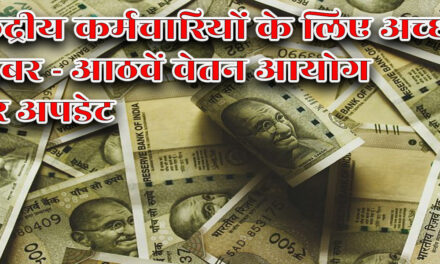
7th Pay Commission was supposed to benefit civilian employees and Defence Forces personnel. The Cabinet in June 2016, had examined 197 allowances, recommending abolition of 53 allowance and subsuming 37 others. Here are some things you cannot miss.
7th Pay Commission: The struggle of 48 lakh central government employees over their minimum pay and fitment factor hike beyond 7th CPC report recommendation has continued for nearly two years now. These employees feel hard done by especially as FM Arun Jaitley had promised to give due consideration to their issue at official venues. However, government employees are still hoping for an increase in the fitment factor and minimum pay, despite the fact that the government has said it is not thinking along those lines at all. The hope are pinned to a list of development taken by government, which leads directly or indirectly to 7th Pay commission drawing attention of all concerned to the matter. Here’s a list of seven things you need to know surrounding the minimum pay and fitment factor hike.
Long-hanging Demand
In June 2016, the government last revised the minimum pay to Rs 18,000 from previous Rs 7,000 per month, along with fitment factor of 2.57 for central government employees. However, showing dissatisfaction employees demand fitment factor of 3.68 times with minimum pay scale of Rs 26,000.
It was known that, the government may hike minimum pay to Rs 21,000 and fitment factor to 3.00 times. However, the NDA government at centre claimed that they are looking to hike minimum pay beyond the recommendations of the 7th CPC.
Assurances were provided by a group of ministers including Home Minister Rajnath Singh, Finance Minister Arun Jaitley on June 30, 2016, that the high level committee will be increasing minimum pay and fitment formula.
Presidents & Lieutenant Governors of Union Territories see hike pay hikes
Just days ago, salaries of Lt. Governors have been hiked to a level that the 7th Pay Commission panel had recommended for secretary level officers. Now, the LG will get pay equal to those of secretaries of the central government.
After the implementation of the 7th Pay Commission award on January 1, 2016, the top-most bureaucrat in the country, the cabinet secretary, gets Rs 2.5 lakh pay per month, while a secretary draws Rs 2.25 lakh per month.
This decision was taken just months after Finance Minister Arun Jaitley had announced in his 2018-19 Budget that emoluments of the President would be revised to Rs 5 lakh, Rs 4 lakh for the vice president and to Rs 3.5 lakh per month for the governors.
Lower-level employees pay scale
Earlier reports had mentioned that FM Jaitley will prefer to pick and choose lower-level employees and pay hike accordingly rather than salary hike for middle-level employees.
Further, the report said that the broad middle-level employees will not see much of a raise, mirroring a long-running trend of income polarization and a shrinking middle-level staff in the central government departments.
The government employees, who receive salaries from pay matrix level 1 to 5, are expected to receive hike in minimum pay scale to Rs 21,000 from Rs 18,000 from April 1, 2018.
These employees will reportedly see an increase in their fitment factor from 2.57 times to 3.00 times of the basic pay of 6th Pay Commission.
Retirement age of govt employees
Employees minimum pay and fitment factor issue may not be dead as yet. The deliberations and discussions may still be on.
It is being said that, on top of the discussions is the matter of increasing the retirement age of the central government employees from 60 to 62 years. For this, Madhya Pradesh model is being studied.
Earlier Madhya Pradesh Chief Minister Shivraj Singh Chouhan stated that, the government will raise the retirement age from 60 to 62 for ensuring that all benefits are reached to employees.
Arrears unlikely if pay scale hike implemented
The news over arrears have been doing the rounds for quite some time now, that if the Centre plans to give a hike in pay scale and fitment factor, then that will be the end of central government employees arrears.
It was believed that employees will soon see a Rs 3000 rise in their minimum payscale, increasing the minimum basic pay from Rs 18,000 to Rs 21,000. But that too is not confirmed as yet.
In fact, it may not happen to pass at all.
Financial advisors to the government are of the view that arrears on higher minimum pay will bring an extra burden to the exchequer.
Annual salary revision hope
Recent buzz also mentioned that the NDA government may soon make revision in annual salaries and allowances of central government employees. This move is expected to be announced before 2019 General elections.
State governments to please their employees ahead of elections
Since the next year will witness the elections, several state governments are toying with the idea to please their employees. Among such states is Tripura, which recently went through assembly polls, and Chief Minister Biplab Kumar Deb along with Assam Finance Minister Himanta Biswa Sarma held discussions in connection with the implementation of seventh pay commission in the state. Madhya Pradesh is another state to have cleared significant benefits for its employees by increasing their retirement age from 60 to 62 years.
What is clear is that an air of uncertainty is hanging over the issue and central government employees will just have to wait, watch and hope for the best.
Source:- ZEE NEWS


